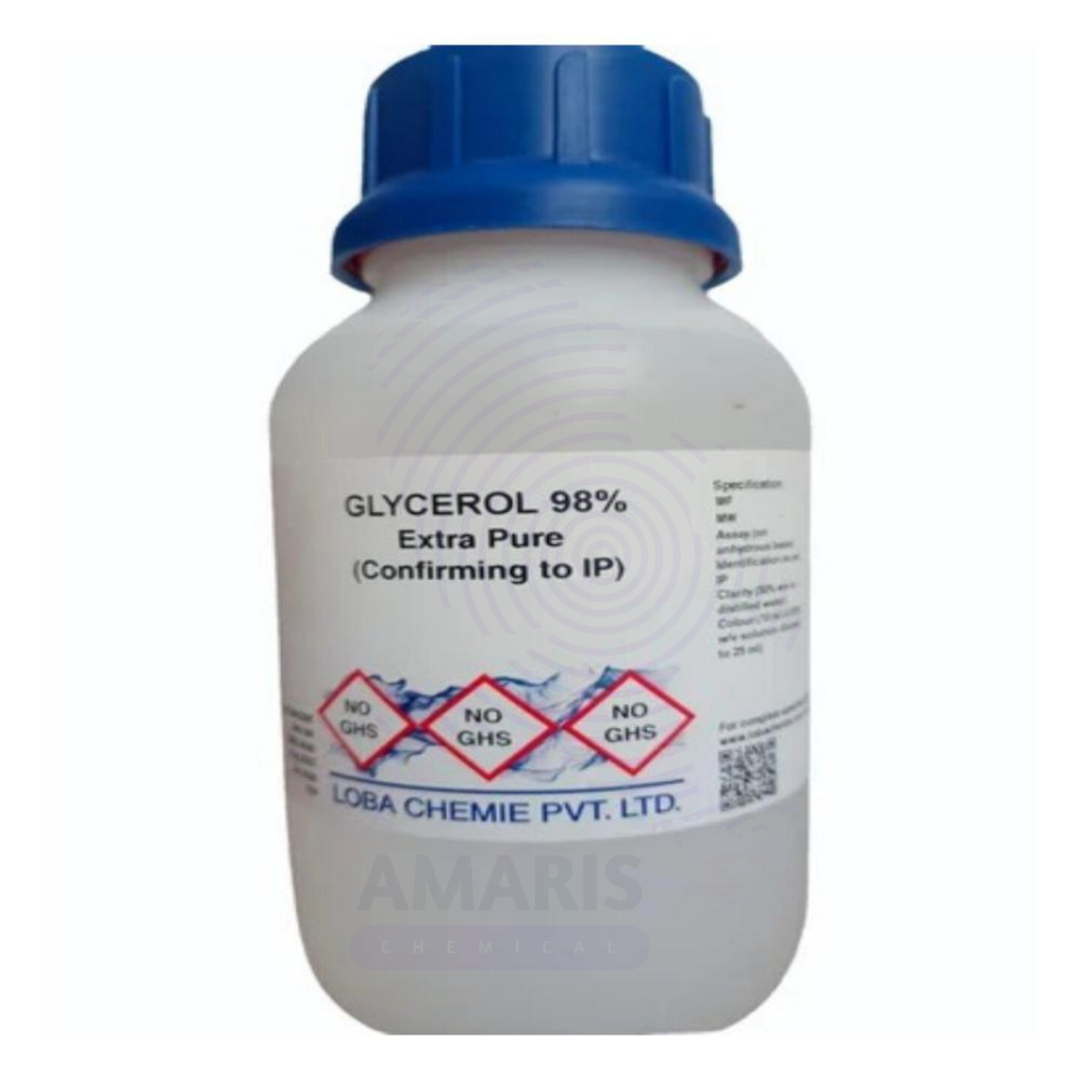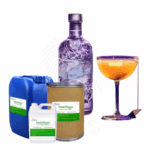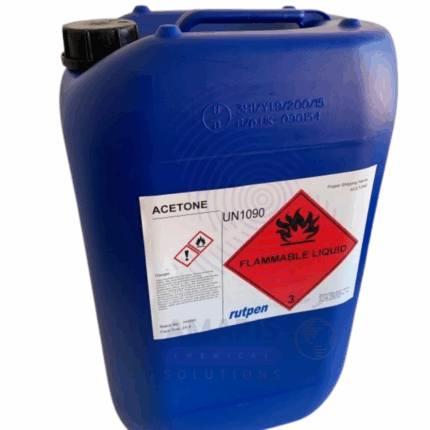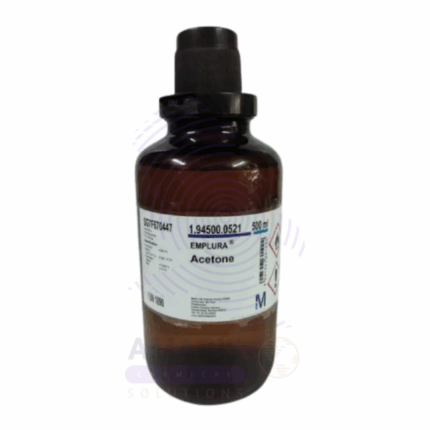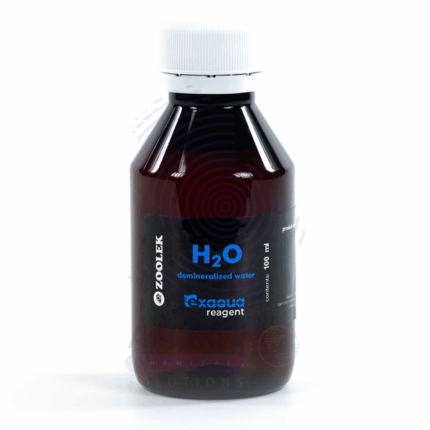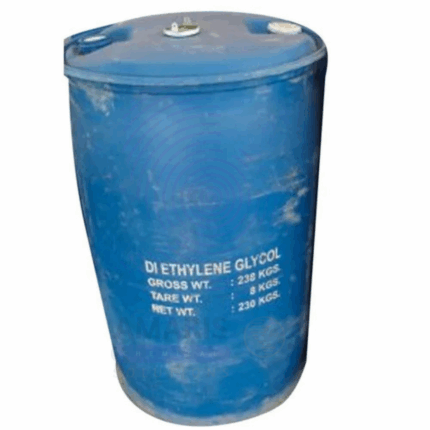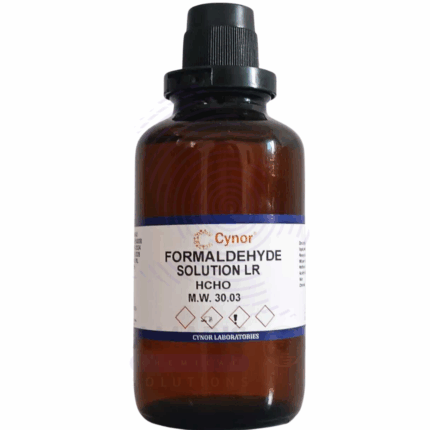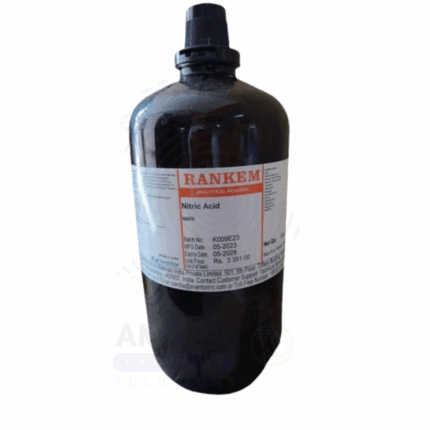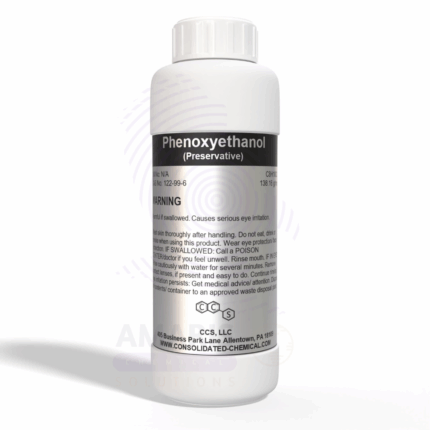Glycerol Extra Pure
$ 36.92 Original price was: $ 36.92.$ 36.75Current price is: $ 36.75.
Glycerol Extra Pure is a clear, viscous, and odorless liquid widely valued for its hygroscopic and solvent properties. With a purity suitable for laboratory, pharmaceutical, and analytical applications, it serves as a versatile reagent and humectant. In laboratories, Glycerol is commonly used in sample preservation, preparation of enzyme storage solutions, and as a stabilizing agent in electrophoresis gels. Its non-toxic and biodegradable nature also makes it ideal for educational experiments and sensitive chemical processes. Its high purity ensures consistent performance in both qualitative and quantitative analysis.
Glycerol Extra Pure
Primary Uses
- Cryoprotectant in biological storage:
Widely used to preserve cells, enzymes, and bacteria during freezing by preventing ice crystal formation. - Molecular biology reagent:
Commonly used in enzyme storage buffers, sample loading buffers for electrophoresis, and DNA/RNA preservation.
Secondary Uses
- Viscosity modifier in chemical formulations:
Acts as a thickener or stabilizer in the preparation of lab-grade lotions, gels, and emulsions. - Calibration and reference standard:
Employed in refractive index calibration and density measurement experiments. - Solvent in pharmaceutical and food simulations:
Used in dissolution testing, and solubility experiments due to its hygroscopic and non-toxic nature.
| PACK SIZE |
2.5 Litres Plastic bottle |
|---|
1. Basic Identification Attributes
- Chemical Name: Glycerol
- Other Names: Glycerin, 1,2,3-Propanetriol
- Chemical Formula: C₃H₈O₃
- CAS Number: 56-81-5
- Molecular Weight: 92.09 g/mol
- Grade: Extra Pure (Laboratory Reagent Grade)
- Appearance: Clear, colorless, viscous liquid
- Odor: Odorless or faintly sweet
2. Physical & Chemical Properties
- Boiling Point: ~290 °C (decomposes)
- Melting Point: ~18 °C
- Density: ~1.26 g/cm³ at 20 °C
- Viscosity: High; ~945 cP at 20 °C
- Solubility: Miscible with water and alcohol; slightly soluble in ether
- Refractive Index: ~1.473
3. Safety & Hazard Attributes
- Hazard Classification (GHS):
✅ Non-hazardous under typical laboratory use - Hazard Statements:
- Not classified as hazardous, but may cause mild eye/skin irritation with prolonged contact
- PPE Requirements:
- Lab coat
- Gloves (nitrile recommended)
- Safety goggles
- First Aid Measures:
- Inhalation: Not expected to pose a hazard; move to fresh air if discomfort occurs
- Skin Contact: Wash with soap and water
- Eye Contact: Rinse with water for several minutes
- Ingestion: Non-toxic in small quantities, but seek medical advice for large ingestion
4. Storage & Handling Attributes
- Storage Conditions:
- Store in a tightly sealed container
- Keep in a cool, dry, well-ventilated place
- Protect from excessive heat and light
- Handling Notes:
- Avoid contamination
- Use clean dispensing tools to prevent microbial growth
- Clean up spills immediately (slippery on floors)
5. Regulatory & Compliance Attributes
- Food/Pharma Relevance:
- GRAS status (Generally Recognized As Safe) for food/pharma (non-lab grade)
- Found in USP, BP, and FCC for specific purities
- Labeling Compliance:
- GHS-compliant labeling preferred for lab supply
- No significant environmental hazard
6. Laboratory Applications
- Primary Uses:
- Used as a solvent and humectant in laboratory preparations
- Medium for enzyme reactions or sample preservation
- Component in buffer solutions and biological media
- Secondary Uses:
- Cryoprotectant in microbiology and cell storage
- Viscosity modifier in reagents and formulations
- Calibration fluid in refractometry
SAFETY PRECAUTIONS
Personal Protective Equipment (PPE):
- Wear lab coat, nitrile gloves, and safety goggles.
- Use in a well-ventilated area or fume hood if heated.
Handling:
- Avoid contact with eyes and prolonged skin exposure.
- Prevent spills and clean up immediately to avoid slipping hazards.
- Wash hands thoroughly after use.
Storage:
- Store in a tightly closed container.
- Keep in a cool, dry, well-ventilated area away from direct sunlight and heat.
- Avoid storage near strong oxidizers.
FIRST AID MEASURES
Inhalation:
- Move person to fresh air.
- Seek medical attention if symptoms such as coughing or dizziness occur.
Skin Contact:
- Wash skin with soap and water.
- Remove contaminated clothing.
- Seek medical advice if irritation develops.
Eye Contact:
- Rinse immediately with plenty of water for at least 15 minutes.
- Remove contact lenses if present and easy to do.
- Get medical attention if irritation persists.
Ingestion:
- Rinse mouth with water.
- Do not induce vomiting.
- Seek medical attention if large quantities are swallowed or if symptoms occur.
FIRE FIGHTING MEASURES
Flammability:
- Slightly combustible; may ignite at high temperatures.
Extinguishing Media:
- Use dry chemical, CO₂, alcohol-resistant foam, or water spray.
Hazardous Combustion Products:
- May release acrolein and carbon oxides upon thermal decomposition.
Firefighter Protection:
- Use self-contained breathing apparatus (SCBA) and full protective clothing.
- Avoid inhaling smoke or vapors during fire suppression.


 Preservatives(food)
Preservatives(food) Flavor Enhancers
Flavor Enhancers Acidulants
Acidulants Sweeteners
Sweeteners Antioxidants
Antioxidants Colorants(food)
Colorants(food) Nutraceutical Ingredients (food)
Nutraceutical Ingredients (food) Nutrient Supplements
Nutrient Supplements Emulsifiers
Emulsifiers
 Collectors
Collectors Dust Suppressants
Dust Suppressants Explosives and Blasting Agents
Explosives and Blasting Agents Flocculants and Coagulants
Flocculants and Coagulants Frothers
Frothers Leaching Agents
Leaching Agents pH Modifiers
pH Modifiers Precious Metal Extraction Agents
Precious Metal Extraction Agents
 Antioxidants(plastic)
Antioxidants(plastic) Colorants (Pigments, Dyes)
Colorants (Pigments, Dyes) Fillers and Reinforcements
Fillers and Reinforcements Flame Retardants
Flame Retardants Monomers
Monomers Plasticizers
Plasticizers Polymerization Initiators
Polymerization Initiators Stabilizers (UV, Heat)
Stabilizers (UV, Heat)
 Antifoaming Agents
Antifoaming Agents Chelating Agents
Chelating Agents Coagulants and Flocculants
Coagulants and Flocculants Corrosion Inhibitors
Corrosion Inhibitors Disinfectants and Biocides
Disinfectants and Biocides Oxidizing Agents
Oxidizing Agents pH Adjusters
pH Adjusters Scale Inhibitors( water)
Scale Inhibitors( water)
 Antioxidants(cosmetic)
Antioxidants(cosmetic) Emollients
Emollients Fragrances and Essential Oils
Fragrances and Essential Oils Humectants
Humectants Preservatives
Preservatives Surfactants(cosmetic)
Surfactants(cosmetic) Thickeners
Thickeners UV Filters
UV Filters
 Fertilizers
Fertilizers Soil Conditioners
Soil Conditioners Plant Growth Regulators
Plant Growth Regulators Animal Feed Additives
Animal Feed Additives Biostimulants
Biostimulants Pesticides (Herbicides, Insecticides, Fungicides)
Pesticides (Herbicides, Insecticides, Fungicides)
 Active Pharmaceutical Ingredients (APIs)
Active Pharmaceutical Ingredients (APIs) Excipients
Excipients Solvents(pharmaceutical)
Solvents(pharmaceutical) Antibiotics
Antibiotics Antiseptics and Disinfectants
Antiseptics and Disinfectants Vaccine Adjuvants
Vaccine Adjuvants Nutraceutical Ingredients (pharmaceutical)
Nutraceutical Ingredients (pharmaceutical) Analgesics & Antipyretics
Analgesics & Antipyretics
 Analytical Reagents
Analytical Reagents Solvents(lab)
Solvents(lab) Chromatography Chemicals
Chromatography Chemicals Spectroscopy Reagents
Spectroscopy Reagents microbiology-and-cell-culture-reagents
microbiology-and-cell-culture-reagents Molecular Biology Reagents
Molecular Biology Reagents Biochemical Reagents
Biochemical Reagents Inorganic and Organic Standards
Inorganic and Organic Standards Laboratory Safety Chemicals
Laboratory Safety Chemicals Specialty Laboratory Chemicals(Special Laboratory Equipment)
Specialty Laboratory Chemicals(Special Laboratory Equipment)
 Demulsifiers
Demulsifiers Hydraulic Fracturing Fluids
Hydraulic Fracturing Fluids Scale Inhibitors(oil)
Scale Inhibitors(oil) Surfactants(oil)
Surfactants(oil) Drilling Fluids
Drilling Fluids
 Dyes and Pigments
Dyes and Pigments Bleaching Agents
Bleaching Agents Softening Agents
Softening Agents Finishing Agents
Finishing Agents Antistatic Agents
Antistatic Agents
 Admixtures
Admixtures Waterproofing Agents
Waterproofing Agents Sealants and Adhesives
Sealants and Adhesives Curing Compounds
Curing Compounds Concrete Repair Chemicals
Concrete Repair Chemicals Anti-Corrosion Coatings
Anti-Corrosion Coatings
 Surfactants(cleaning)
Surfactants(cleaning) Builders
Builders Enzymes
Enzymes Solvents (Cleaning)
Solvents (Cleaning) Fragrances
Fragrances
 Electronic Chemicals
Electronic Chemicals Catalysts
Catalysts Lubricants
Lubricants Photographic Chemicals
Photographic Chemicals Refrigerants
Refrigerants Automotive chemicals
Automotive chemicals Pyrotechnic Chemicals
Pyrotechnic Chemicals
 Biodegradable Surfactants
Biodegradable Surfactants Bio-based Solvents
Bio-based Solvents Renewable Polymers
Renewable Polymers Carbon Capture Chemicals
Carbon Capture Chemicals Wastewater Treatment Chemicals
Wastewater Treatment Chemicals
 Pigments
Pigments Solvents(paint)
Solvents(paint) Specialty Coatings
Specialty Coatings Binders/Resins
Binders/Resins Additives
Additives Driers
Driers Anti-Corrosion Agents
Anti-Corrosion Agents Functional Coatings
Functional Coatings Application-Specific Coatings
Application-Specific Coatings
 Fresh Herbs
Fresh Herbs Ground Spices
Ground Spices Whole Spices
Whole Spices Spice Blends
Spice Blends Dried Herbs
Dried Herbs
 Leavening Agents
Leavening Agents Dough Conditioners
Dough Conditioners Flour Treatments
Flour Treatments Fat Replacers
Fat Replacers Decoratives
Decoratives Preservatives(baking)
Preservatives(baking)
 Plasticizers & Softeners
Plasticizers & Softeners Reinforcing Agents
Reinforcing Agents Adhesion Promoters
Adhesion Promoters Vulcanizing Agents
Vulcanizing Agents Antidegradants
Antidegradants Blowing Agents
Blowing Agents Fillers & Extenders
Fillers & Extenders Accelerators & Retarders
Accelerators & Retarders